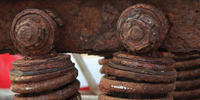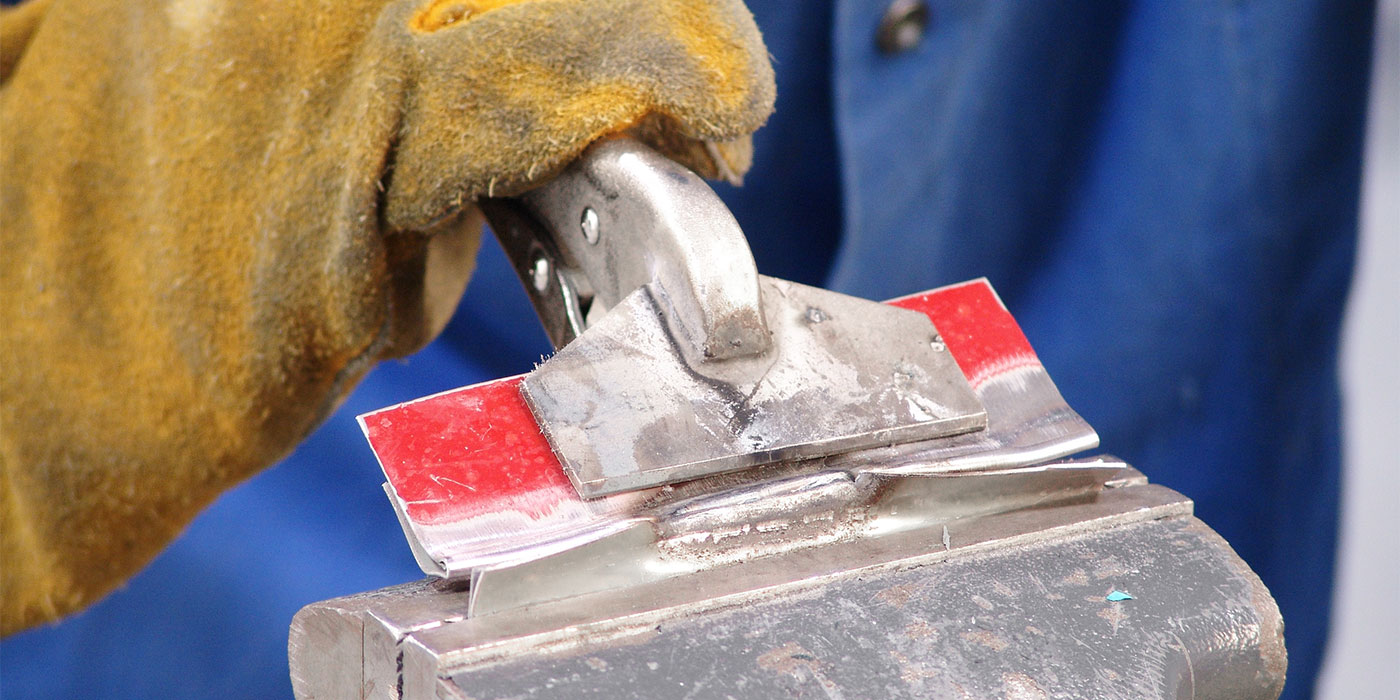Some shop owners shy away from rust repair like it’s the plague, while others use it to keep busy when things are slow. Then there are some who make a living doing nothing but rust repair.
It seems there isn’t any in between when it comes to rust. You either love it or hate it.
What exactly is rust? It’s a form of corrosion in which oxygen combines with metal, causing it to turn a beautiful reddish brown color. (Beautiful probably isn’t the right word!) Left unchecked, the reddish brown color eventually gives way to pits and then holes. And there’s nothing beautiful about that.
The deterioration process takes time, but the cause of rust is certainly no secret. Bare steel plus moisture, plus oxygen, plus time equals rust. Want to speed up the rusting process? Add a little salt to the recipe.
Although rust is more common in certain geographical areas of the country, there probably isn’t a collision technician alive who hasn’t at least seen what rust can do. And most vehicle owners have also witnessed, but weren’t happy about, what rust can do.
While modern vehicles are less prone to rust, that doesn’t mean they won’t ever rust. Poorly done previous repairs, age of the vehicle, type of driving and other environmental conditions all contribute to rust. Still, it’s a lot better than it used to be. Before coated steel and the OEM “E” coat, many vehicles literally rusted from the inside out.
Considering all these advances in the battle against rust, is rust repair worth your time?
It depends whom you ask. To understand what goes into rust repair — and if it’s something you should consider for your business — let’s take a look at some types of rust repair.
On the Surface
One of the simplest rust repairs is surface rust, which begins once the integrity of the paint and “E” coat have been broken. Coated or galvanized steel helps delay the process but, eventually, the result is the same: rust. All it takes is one little rock chip in the paint. The spot, if left alone, usually gets bigger and bigger until what started out as a 1/8-inch rust pit becomes a much larger series of rust pits — ugly to say the least.
Repairing surface rust is relatively easy — but it still must be done properly. This is the time to catch rust before it becomes a rust out, and the secret is to remove as much of the rust as possible with mechanical means. Use a sander or wire brush, then follow up with a metal conditioner. Sand blasting may be an alternative to grinding, sanding or wire brushing, but watch for panel distortion.
After the rust is removed and conditioned, apply a two-part epoxy primer. Self-etching primer may also be used, but controlling the mil thickness is critical. If the pits are deep enough, they’ll need to be filled with plastic filler. Some technicians like to apply the two-part epoxy primer and then apply the plastic filler. This method seems to work extremely well, but if you haven’t used this method, check with you jobber for suggestions and recommendations. And don’t forget, you can’t apply plastic filler over self-etching primer.
Rust-Out Repairs
When the rust goes long enough, surface rust becomes a rust out. (It should be mentioned that surface rust and rust outs can also occur from the inside out.) Rust outs are not only ugly but dangerous to the vehicle driver and passengers because modern unibody vehicles rely on the strength of every single panel and member to maintain crash worthiness and structural integrity. Even the bodies on full-frame vehicles are crucial to the vehicle’s crash performance. A full-size pick-up truck with a fourth of the door rusted out and one half of the rocker panel gone isn’t any safer than a rusted-out unibody vehicle. Both vehicles need repairs.
Repairing rust outs is more complicated than repairing surface rust. Is the vehicle unibody construction or full frame? For full-frame vehicles, ask yourself, are the exterior panels rusted out or is the frame rusted as well? What’s the condition of the body mounts? For unibody vehicles, what’s the condition of the main structural members, like rails, rockers, pillars, etc.? What’s the condition of the fenders, doors, quarters, etc.? Severely rusted-out vehicles probably belong in the scrap yard. The exception to this rule is antique or classic cars.
If you’re going to repair rust outs on exterior panels, you have three options:
- The fast and economical method. Just remember, a fast method isn’t typically a long-term solution.
- New steel (new steel could mean a replacement panel or new or aftermarket parts).
- The fiberglass replacement panel.
- Fast and economical — One of the quick methods is to grind off the paint around the rust-out area, and then fill it up with a waterproof filler. If the hole or holes are too large, you could back up the hole with urethane foam. For a little longer-lasting repair, you might grind off as much rust as possible, apply a rust-inhibitor (the stuff that turns black when in contact with rust) and then fill over the area. Neither method is truly long-lasting though.
The only reason for discussing quick methods is so you know they’re quick with a relatively low cost. They’re not, however, long-lasting solutions. If you have a customer who wants a fast, economical repair, make sure he understands the limitations of these types of repairs.
New steel — When you consider new steel for a rust repair, you have several options.
Complete panel replacement is expensive, but it results in a quality, long-lasting rust repair. This is the only way to go on structural members on the typical unibody vehicle. Rusted-out unibody structural members must be treated the same as a collision-damaged structural member. If you can’t correctly section in a new portion of the structural member to eliminate the rust out, replace the entire member.
Rusted-out structural members are rare, but you may encounter one either because it was previously repaired without restoring anti-corrosion protection or because an OEM design or parts problem. The age of the vehicle or other environmental conditions may also contribute to the rust-out problem. It really doesn’t matter as long as you remember that rusted-out unibody vehicles require special considerations to make sure they’re repaired correctly.
Another steel option for exterior panel rust outs are rust-repair panels. Basically, the rust-repair panel fits over the existing panel at the spot where the rust is. The repair panel usually extends out beyond the area that’s prone to rust by several inches or more. The idea is to remove the really bad portions of the rust out, and then weld the rust-repair panel in place.
The choice of welding can either be one-sided spot welding or MIG welding, continuous seam or plug welds. Just remember, if you choose one-sided spot welding or MIG plug welds, it’s difficult to achieve a water-tight seam. And if moisture gets behind the new repair within nine months (depends on the climate, exposure to salt and moisture, etc.), the vehicle is right back where you started. In some cases, this may be acceptable to the customer — in other cases, it may not be.
If your customer is looking for a long-term repair, then all new panels using all of the modern anti-corrosion weapons is the way to go. This type of repair isn’t cheap, so it won’t be for those customers looking to extend the life of their vehicles by only a couple more years. However, this type of repair may be for the customer who’s looking for a “new car” look on an older vehicle that’s sound mechanically. A good example is pick-up trucks. Pick-up trucks hold their value well, which makes them a prime target for selling quality rust repairs.
The success of this type of repair means that all existing rust must be removed and new metal put in its place. When you do that, use all of the modern materials to restore corrosion protection that you’d use on any late-model vehicle repair. This means all bare steel must be coated with a quality self-etching or two-part epoxy primer, and the anti-corrosion materials and undercoating products, seam sealers, etc., must be used in the proper sequence and according the product manufacturer’s recommendations.
If you’re going to weld in a steel repair panel, consider using a weld-through primer at the immediate weld site. Use skip-welding techniques and short welds to minimize distortion, and make sure the starts and stops fuse together. Otherwise, moisture will get behind the repair. If the panel distorts, try to straighten it as much as possible rather than just filling in the low spots. Remember, plastic fillers have limits with regard to thickness, which usually vary from 1/8 inch to 1/4 inch.
Some technicians use pop rivets rather than welding to fasten the steel panels. This works as far as securing the panel in place, but the pop rivets have a tendency to loosen after a while, permitting moisture to get in the repair area.
• Fiberglass repair panels — Repairing rust outs with fiberglass isn’t new, but using fiberglass repair panels instead of steel panels is. This method offers several advantages — the first being that you don’t have to weld them in place, which automatically eliminates the distortion problem that’s associated with welding in a steel panel.
The procedure for applying fiberglass panels is relatively simple. First, you remove the paint from the repair area 3 to 4 inches beyond the actual size of the fiberglass panel. Rough up the back side of the fiberglass panel and apply a thin layer of standard plastic filler. Apply the panel to the vehicle, press it into place and hold it until the filler sets. After the panel is in place, you can taper or featheredge the fiberglass to the steel joint by applying additional filler. Then sand to shape and contour.
Is Repairing Rust a Must?
Dealing honestly with customers and knowing your costs for performing rust repairs are essential. These two things may well be the key to successfully performing rust repairs. Unfortunately, honesty sometimes gets lost in the “business” of making a profit.
Short-term rust repairs and long-term rust repairs are like day and night. And even best efforts sometimes fail to make a long-term rust repair last longer than six months. For reasons such as this, customers need be informed of the cost of different rust-repair methods vs. their longevity.
And don’t ever forget that rust repairs must ensure the vehicle’s structural integrity — this is an absolute must for unibody vehicles. Know when to say, “No, this vehicle cannot be made safe for the road.”
As with any profit center, rust repairs can provide additional profits to your shop, but they also bring with them additional responsibilities. Is taking on rust repair a smart move for you? Will it be profitable? Is it worth it? It has been for some. But only you can determine if the rust repair aspect of the business is right for your business.














